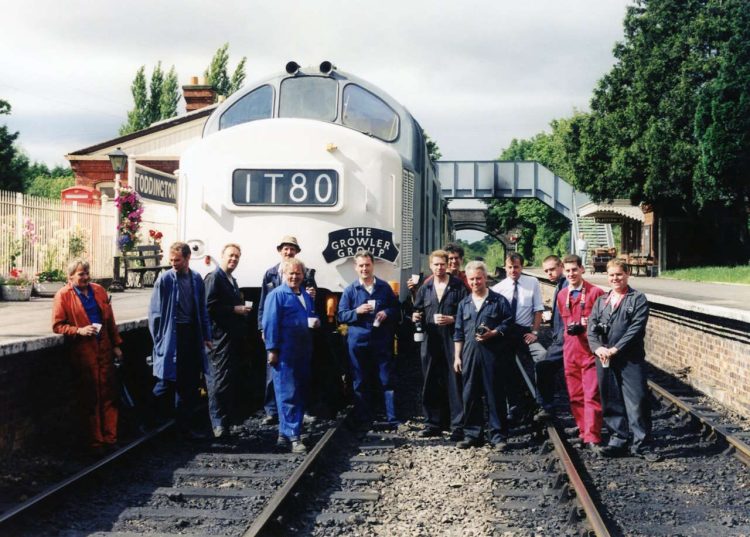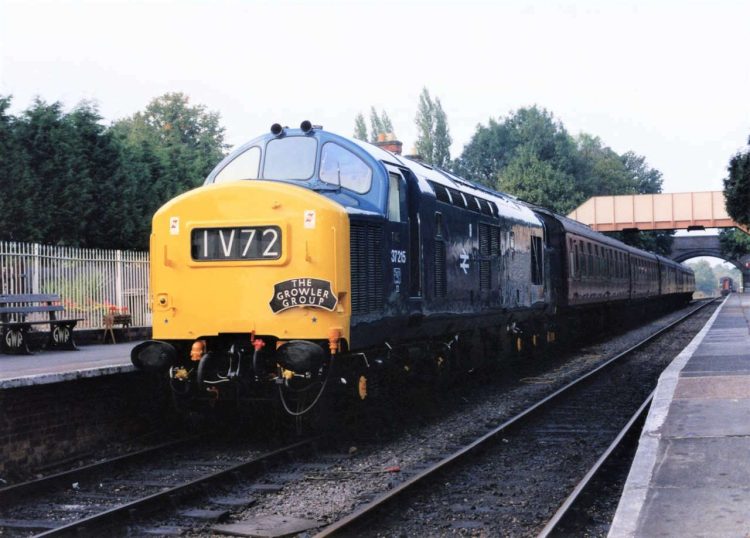Gloucestershire Warwickshire Railway is marking the twenty-fifth anniversary of its English Electric Type 3 / British Rail Class 37 diesel-electric locomotive no. 37215 (D6915) by releasing photographs of its entry into preservation service in 1998.

It will celebrate the anniversary on Sunday 24 September 2023 with the Class 37 locomotives operating trains under the pink timetable.
37215 officially began its preservation service on Friday 25 September 1998, after a test run on 5 July 1998 between Toddington and Gotherington. The anniversary of the test run falls two days before the start of the railway’s annual Summer Heritage Diesel Gala on Friday 7 July.
Class 37s are popular among rail enthusiasts, many of whom refer to them as ‘Tractors’, as they sound quite similar to the agricultural vehicles. The locos were known for their versatility and reliability, easily hauling heavy freight trains and mainline passenger services on primary and secondary routes.
English Electric built 309 Class 37 locomotives between 1960 and 1965, at two sites: Vulcan Foundry in Newton-le-Willows, Lancashire, and Robert Stephenson & Hawthorns in Darlington. 37215 (D6915) is a 37/0, and was one of those built at the Vulcan Foundry.
Completed in late 1963, D6915 was delivered new to Swansea Landore depot (87E) during January 1964, and spent the next three-and-a-half years mainly hauling freight trains around the Swansea and West Wales areas.
In October 1967 it transferred to Wakefield shed in West Yorkshire, then moved to its replacement, the newly-built Healey Mills diesel depot (55C), two months later, from where it worked coal and other freight services around Yorkshire and across the Pennines into Lancashire.

The Class 37 locomotives had a low axle load and a route availability of five (RA5), so could travel virtually anywhere on the national rail network. Several subclasses were developed, to enable a longer their lifespan. Ninety locomotives still exist, some in active mainline service, some in long-term storage, and some in preservation.
In October 1968, the ‘D’ prefix was dropped, and during October 1971, 6915 moved to Tinsley depot (41A) near Sheffield in South Yorkshire. Two years later, in September 1973, it moved to Stratford depot (SF) in East London, and spend the next eight-and-a-bit year working on the Great Eastern lines from London into East Anglia. This included servicing Essex and Thameside’s many freight facilities in the Essex and north Thameside area, including travelling around the north London line into the Southern and Western regions. During this time, in March 1974, the loco was renumbered 37215.
In January 1982, it returned to Tinsley depot (TI), and spent the next six years hauling trains around Yorkshire, including regular Saturday seaside trips from the Sheffield area to resorts such as Blackpool, Scarborough and Skegness.
Between November 1987 and May 1988, the loco moved quickly from Tinsley (TI) to Immingham (IM) then Stratford (SF) and finally Cardiff Canton (CF), where it became part of the Trainload Petroleum fleet, spending the next four years working heavy oil trains out of South Wales to terminals across the south of England. It usually worked in a pair with another Class 37.
37215 went into storage in August 1992, moving to Inverness depot (IS) and being officially withdrawn on 16 July 1993. It was subsequently bought for preservation by The Growler Group then bought it for preservation, and moved it to GWR’s Toddington site road. It arrived on 23 June 1994, where work began to restore it to operational condition.
The locomotive returned to full working order in July 1998 and after several test runs, its paintwork was finished on 25 August 1998. In 2007, 37215 was repainted in British Rail blue livery as the class wore during the 1970s and ’80s.
Tickets for GWSR’s summer diesel gala are available online on the Railway’s website. The event will feature up to eight diesel locomotives and a diesel multiple unit (DMU) in operation. The locomotive and carriage & wagon workshops will be open for behind-the-scenes visits. Other activities will take place at the railway’s period stations.






Responses
I photographed 37215 for the local press as it left Inverness Depot by road for the G&WR. We knew many of The Growler Group at the time.